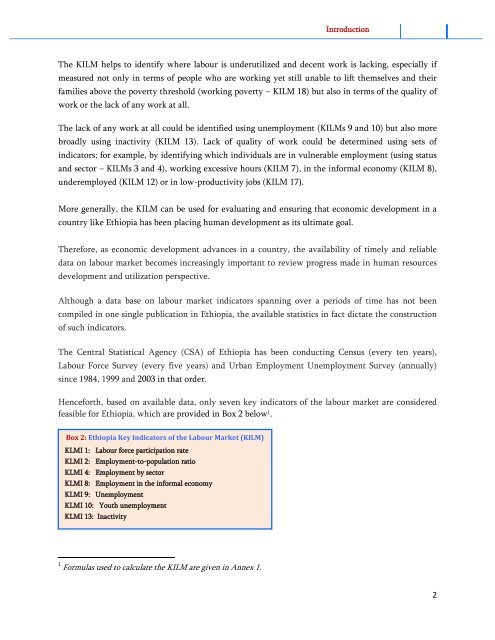Ethiopia KILM
Ethiopia KILM
Ethiopia KILM
- No tags were found...
You also want an ePaper? Increase the reach of your titles
YUMPU automatically turns print PDFs into web optimized ePapers that Google loves.
Introduction<br />
The <strong>KILM</strong> helps to identify where labour is underutilized and decent work is lacking, especially if<br />
measured not only in terms of people who are working yet still unable to lift themselves and their<br />
families above the poverty threshold (working poverty – <strong>KILM</strong> 18) but also in terms of the quality of<br />
work or the lack of any work at all.<br />
The lack of any work at all could be identified using unemployment (<strong>KILM</strong>s 9 and 10) but also more<br />
broadly using inactivity (<strong>KILM</strong> 13). Lack of quality of work could be determined using sets of<br />
indicators; for example, by identifying which individuals are in vulnerable employment (using status<br />
and sector – <strong>KILM</strong>s 3 and 4), working excessive hours (<strong>KILM</strong> 7), in the informal economy (<strong>KILM</strong> 8),<br />
underemployed (<strong>KILM</strong> 12) or in low-productivity jobs (<strong>KILM</strong> 17).<br />
More generally, the <strong>KILM</strong> can be used for evaluating and ensuring that economic development in a<br />
country like <strong>Ethiopia</strong> has been placing human development as its ultimate goal.<br />
Therefore, as economic development advances in a country, the availability of timely and reliable<br />
data on labour market becomes increasingly important to review progress made in human resources<br />
development and utilization perspective.<br />
Although a data base on labour market indicators spanning over a periods of time has not been<br />
compiled in one single publication in <strong>Ethiopia</strong>, the available statistics in fact dictate the construction<br />
of such indicators.<br />
The Central Statistical Agency (CSA) of <strong>Ethiopia</strong> has been conducting Census (every ten years),<br />
Labour Force Survey (every five years) and Urban Employment Unemployment Survey (annually)<br />
since 1984, 1999 and 2003 in that order.<br />
Henceforth, based on available data, only seven key indicators of the labour market are considered<br />
feasible for <strong>Ethiopia</strong>, which are provided in Box 2 below 1 .<br />
Box 2: <strong>Ethiopia</strong> Key Indicators of the Labour Market (<strong>KILM</strong>)<br />
KLMI 1: Labour force participation rate<br />
KLMI 2: Employment-to-population ratio<br />
KLMI 4: Employment by sector<br />
KLMI 8: Employment in the informal economy<br />
KLMI 9: Unemployment<br />
KLMI 10: Youth unemployment<br />
KLMI 13: Inactivity<br />
1 Formulas used to calculate the <strong>KILM</strong> are given in Annex 1.<br />
2


